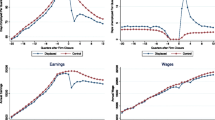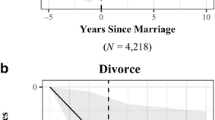Abstract
This study examines the interplay between job stability, wage rates, and marital stability. We use a Dynamic Selection Control model in which young men make sequential choices about work and family and estimate the model using an approach that takes account of self-selection, simultaneity and unobserved heterogeneity. The results quantify how job stability affects wage rates, how both affect marital status, and how marital status affects earnings and job stability. The study reveals robust evidence that job changes lower wages and the likelihood of getting married and remaining married. At the same time, marriage raises wage rates and job stability. To project the sequential effects linking job change, marital status, and earnings, we simulate the impacts of shocks that raise preferences for marriage and that increase education. Feedback effects cause the simulated wage gains from marriage to cumulate over time, indicating that long-run marriage wage premiums exceed conventional short-run estimates.
Similar content being viewed by others
Notes
We conducted robustness tests and found the results were similar with and without the 366 individuals who completed less than 10 interviews.
Tabulations on the reasons for job change for the nonmissing cases are available on request.
Because these results yielded similar results to our main model, we do not report them, but they are available on request.
If the increased attractiveness of men raises their expectations of partners (as in their reservation wage in the case of job search), it is possible that the higher wage will not increase entry into marriage (Burdett and Coles 1999).
The coefficients across marital statuses k = 2,4,6 are not constrained to be the same.
In principle, the county divorce rate could affect (indirectly) job stability. In fact, county divorce rates are not correlated with job turnover or wage rates. The simple correlation between job change and county divorce rate is 0.0041. The simple correlation between marital changes and county divorce rate is 0.0787.
A reanalysis of Gray’s results shows that extending his model to many years raises the wage premium significantly (Ahituv and Lerman 2007).
For a summary of the activities taking place under this “Healthy Marriage Initiative” see the following website: http://www.acf.dhhs.gov/healthymarriage/index.html.
References
Ahituv, A., & Lerman, R. I. (2007). How do marital status, wage rates, and work effort Interact. Demography, 44(3), 623–647.
Ahituv, A., & Tienda, M. (2004). Employment activity, motherhood and school continuation decisions of young white, Black and Hispanic women. Journal of Labor Economics, 22(1), 115–158.
Becker, G. S. (1974). A Theory of Marriage. In T. W. Schultz (Ed.), Economics of the family. Chicago: Chicago University Press.
Becker, G. S., Landes, E., & Michael, R. (1977). An economic analysis of marital instability. Journal of Political Economy, 85, 1141–1187.
Bernhardt, A., Morris, M., Handcock, M., & Scott, M. (1999). Trends in job stability and wages for young adult men. Journal of Labor Economics, 17:4. Part 2, 65–91.
Bielby, D., & Bielby, W. (1988). She works hard for the money: Household responsibilities and the allocation of work effort. American Journal of Sociology, 93(5), 1031–1059.
Burdett, K., & Coles, M. (1999). Long-term partnership formation: Marriage and employment. Economic Journal, 109(456), F307–F334.
Call, V., & Teachman, J. (1996). Life-course timing and sequencing of marriage and military service and their effects on marital stability. Journal of Marriage and the Family, 58, 219–226.
Cameron, S., & Heckman, J. (1998). Life cycle schooling and dynamic selection bias: Models and evidence for five cohorts of American males. Journal of Political Economy, 106, 262–333.
Charles, K., & Stephens, M., Jr. (2004). Job displacement, disability, and divorce. Journal of Labor Economics, 22(2), 489–522.
Chun, H., & Lee, I. (2001). Why do married men earn more: Productivity or marriage selection? Economic Inquiry, 39(2), 307–319.
Cornwell, C., & Rupert, P. (1997). Unobservable individual effects, marriage, and the earnings of young men. Economic Inquiry, 35(April), 285–294.
Daniel, K. (1995). The marriage premium. In M. Tommasi & K. Ierulli (Eds.), The new economics of human behavior (pp. 113–125). Cambridge, England: Cambridge University Press.
Eckert-Jaffe, O., & Solaz, A. (2001). Unemployment, marriage, and cohabitation in France. The Journal of Socio-Economics, 30, 75–98.
Edin, K., & Kefalas, M. (2005). Promises I can keep: Why poor women put motherhood before marriage. Berkeley and Los Angeles: University of California Press.
Farber, H. (1995). Are lifetime jobs disappearing? Job duration in the United States, 1973–1993, National Bureau of Economic Research no. Working Paper 5014. Cambridge, MA.
Gorman, E. H. (1999). Bringing home the Bacon: Marital allocation of income-earning responsibility, job shifts, and men’s wages. Journal of Family Issues, 61, 110–122.
Gould, D. E. (2003). Marriage and career: The dynamic decisions of young men. The Hebrew University of Jerusalem. Unpublished manuscript.
Gray, J. S. (1996). The fall in men’s return to marriage: Declining productivity effects or changing selection? Journal of Human Resources, 32(3), 481–504.
Grossbard-Shechtman, S. (1993). On the economics of marriage: A theory of marriage, labor, and divorce. Boulder, Colorado: Westview Press.
Hamilton, S. (1990). Apprenticeship for adulthood: Preparing youth for the future. New York, New York: The Free Press.
Hansen, H.-T. (2005). Unemployment and marital dissolution. European Sociological Review, 21(2), 135–148.
Haskins, R., & Sawhill, I. (2003). Work and marriage: The way to end poverty and welfare. Welfare reform and beyond, #28. Washington, DC: Brookings Institution.
Heckman, J. (1979). Sample selection bias as a specification error. Econometrica, 47(1), 153–161.
Heckman, J. J., & Singer, B. (1984). A method for minimizing the impact of distributional assumptions in econometric models of duration analysis. Econometrica, 52, 217–320.
Heckman, J., Urzua, S., & Vytlacil, E. (2006). Understanding instrumental variables in models with essential heterogeneity. Review of Economics and Statistics, 88(3), 389–432.
Hotz, V. J., Xu, L., Tienda, M., & Ahituv, A. (2002). Are there returns to the wages of young men from working while in school? Review of Economics and Statistics, 84(1), 221–236.
Ichimura, H., & Taber, C. (2002). Semiparametric reduced-form estimation of tuition subsidies. American Economic Review, 286–292.
Jovanovic, B. (1979). Job matching and the theory of turnover. Journal of Political Economy, 87(5), 972–990.
Klerman, J. A., & Karoly, L. A. (1994). Young men and the transition to stable employment. Monthly Labor Review, 117(8), 31–48.
Korenman, S., & Neumark, D. (1991). Does marriage really make men more productive? Journal of Human Resources, 26, 282–307.
Light, A., & McGarry, K. (1998). Job change patterns and the wages of young men. Review of Economics and Statistics, 80(2), 276–286.
Manning, W. D., & Smock, P. (1995). Why marry? Race and the transition to marriage among cohabitors. Demography, 32(4), 509–520.
McFadden, D. L. (1984). Econometric analysis of qualitative response models. In Z. Griliches & M. D. Intriligator (Eds.), Handbook of econometrics (Vol. II, pp. 1396–1457). NY: North-Holland.
Mincer, J., & Polachek, S. (1974). Family investments in human capital: Earnings of women. Journal of Political Economy, S76–S108.
Neumark, D. (2000). Changes in job stability and job security: A collective effort to untangle, reconcile, and interpret the evidence. National Bureau of Economic Research. Working Paper 7472. Cambridge, MA.
Neumark, D. (2002). Youth labor markets in the United States: Shopping around or staying put. The Review of Economics and Statistics, 84(3), 462–482.
Nock, S. L. (1998). Marriage in men’s lives. New York: Oxford.
Presser, H. (2000). Nonstandard work schedules and marital instability. Journal of Marriage and the Family, 62(February), 93–110.
Smock, P. J., & Manning, W. D. (1997). Cohabitation partners’ economic circumstances and marriage. Demography, 34(3), 331–341.
Teachman, J. D., Call, V. R. A., & Carver, K. P. (1994). Marital status and the duration of joblessness among White Men. Journal of Marriage and the Family, 56, 415–428.
Topel, R. H., & Ward, M. P. (1992). Job mobility and the careers of young men. Quarterly Journal of Economics, 196, 439–479.
U.S. Bureau of Labor Statistics. (2000). Number of jobs held, labor market activity, and earnings growth over two decades: Results from a longitudinal survey. Washington, DC.
Waite, L. J., & Gallagher, M. (2000). The case for marriage. New York: Doubleday.
Weiss, Y., & Willis, R. J. (1997). Match quality, new information, and marital dissolution. Journal of Labor Economics, 15(1), S293–S329.
Wilcox, W. B., & Nock, S. L. (2006). What’s love got to do with it? Equality, equity, commitment and women’s marital quality. Social Forces, 84, 1321–1345.
Wilson, W. J. (1987). The truly disadvantaged. Chicago: University of Chicago Press.
Wilson, J. Q. (2002). The marriage problem. New York: Harper Collins.
Acknowledgments
The authors thank the National Institute for Child Health and Human Development (NICHD) for financial support for this research grant (RO 3 HD043994-01) to the Urban Institute. We appreciate the useful comments provided by anonymous referees, by the editor, and by seminar participants in the European Summer Symposium in Labor Economics (ESSLE), European Association of Labor Economics (EALE), the University of Haifa and Tel-Aviv University.
Author information
Authors and Affiliations
Corresponding author
Appendix
Rights and permissions
About this article
Cite this article
Ahituv, A., Lerman, R.I. Job turnover, wage rates, and marital stability: How are they related?. Rev Econ Household 9, 221–249 (2011). https://doi.org/10.1007/s11150-010-9101-6
Received:
Accepted:
Published:
Issue Date:
DOI: https://doi.org/10.1007/s11150-010-9101-6




